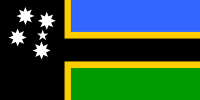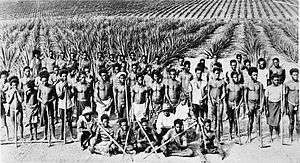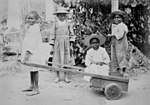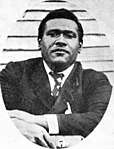South Sea Islanders
In an Australian context, South Sea Islanders refers to Australian descendants of Pacific Islanders from more than 80 islands in the South Seas – including the Melanesian archipelagoes of the Solomon Islands, New Caledonia and Vanuatu – who were kidnapped or recruited between the mid to late 19th century as labourers in the sugarcane fields of Queensland. Some were kidnapped or tricked (or "blackbirded") into long-term indentured service. At its height, the recruiting accounted for over half the adult male population of some islands.
 Flag of the South Sea Islanders | |
 South Sea Islander labourers on a Queensland pineapple plantation, 1890s | |
| Regions with significant populations | |
|---|---|
| Sydney · Brisbane · Gold Coast · Melbourne | |
| Languages | |
| Australian English · | |
| Related ethnic groups | |
| Melanesians |
There were 60,000 people who were kidnapped or “blackbirded”.
These people were generally referred to as Kanakas, which means "man", although many Islander descendants now regard the term as pejorative and an insulting reminder of their ancestors' exploitation at the hands of white planters.
With time, owing to intermarriage, many Australian South Sea Islanders also claim a mixed ancestry, including Aboriginals, Torres Strait Islanders and immigrants from the South Pacific Islands.
Of some 55,000 to 62,500 Islanders recruited, around 10,000 remained in Australia in 1901.[1] The majority were repatriated by the Australian Government in the period between 1906 and 1908 under the Pacific Island Labourers Act 1901,[2] a piece of legislation related to the White Australia policy.[3][4][5] There was resistance to repatriation,[6] and controversy regarding the manner in which it was done.[7]
Those exempted from repatriation, along with a number of others who escaped deportation, remained in Australia to form the basis of what is today Australia's largest non-indigenous black ethnic group. Today, the descendants of those who remained are officially referred to as South Sea Islanders. A 1992 census of South Sea Islanders reported around 10,000 descendants living in Queensland. Fewer than 3,500 were reported in the 2001 Australian census.[8]
The question of how many Islanders were "blackbirded" is unknown and remains controversial. The extent to which Islanders were recruited legally, persuaded, deceived, coerced or forced to leave their homes and travel to Queensland is difficult to evaluate and also controversial. Official documents and accounts from the period often conflict with the oral tradition passed down to the descendants of workers. Stories of blatantly violent kidnapping tend to relate to the first ten or so years of the trade.
Prominent Australian South Sea Islanders
In recent generations, facing many similar forms of discrimination in Australia as Aboriginal Australians and Torres Strait Islanders, Australian South Sea Islanders have been prominent figures in civil rights and politics. Faith Bandler, Evelyn Scott and Bonita Mabo (widow of Eddie Mabo) are prominent Indigenous activists who are also descendants of South Sea Island plantation workers. Stephen Andrew, who represents One Nation in the Queensland Parliament, was the first South Sea Islander to be elected to parliament.
Another area Australian South Sea Islanders have excelled in is sport, especially the game of rugby league. Australian international representatives Mal Meninga, Sam Backo, and Gorden Tallis are all members of the Australian South Sea Islander community.
Gallery
 South Sea Islander woman at Farnborough, Queensland, ca. 1895
South Sea Islander woman at Farnborough, Queensland, ca. 1895 South Sea Islander children at Innisfail, Queensland, ca. 1902–1905
South Sea Islander children at Innisfail, Queensland, ca. 1902–1905 South sea islands liku
South sea islands liku Robert Long. Leader of the South Sea Island Mission at Nambour.
Robert Long. Leader of the South Sea Island Mission at Nambour. South Sea Islanders waiting for deportation, Cairns, 1906. Departure of the first shipment of deported Polynesians from Cairns under the Commonwealth
South Sea Islanders waiting for deportation, Cairns, 1906. Departure of the first shipment of deported Polynesians from Cairns under the Commonwealth
See also
- White Australia Policy
- Kanaka (Pacific Island worker)
References
- Tracey Flanagan, Meredith Wilkie, and Susanna Iuliano. Australian South Sea Islanders: A century of race discrimination under Australian law, Australian Human Rights Commission.
- "Documenting Democracy: Pacific Island Labourers Act 1901 (Cth)". National Archives of Australia: Foundingdocs.gov.au. Archived from the original on 26 October 2009. Retrieved 14 October 2012.
- Lawrence, David Russell (October 2014). "Chapter 9 The plantation economy" (PDF). The Naturalist and his "Beautiful Islands": Charles Morris Woodford in the Western Pacific. ANU Press. p. 257. ISBN 9781925022032.
- Lawrence, David Russell (October 2014). "Chapter 10 The critical question of labour" (PDF). The Naturalist and his "Beautiful Islands": Charles Morris Woodford in the Western Pacific. ANU Press. pp. 295–296. ISBN 9781925022032.
- Stefanie Affeldt: Consuming Whiteness. Australian Racism and the ‘White Sugar’ Campaign. Lit-Verlag, Münster 2014, pp. 152–188.
- "KANAKA DEPORTATION". The Sydney Morning Herald. National Library of Australia. 23 June 1903. p. 5. Retrieved 15 November 2015.
- "KANAKA DEPORTATION". The Brisbane Courier. National Library of Australia. 18 December 1906. p. 4. Retrieved 15 November 2015.
- Tracey Flanagan, Meredith Wilkie, and Susanna Iuliano. "Australian South Sea Islanders: A Century of Race Discrimination under Australian Law", Australian Human Rights Commission.
External links
| Wikimedia Commons has media related to South Sea Islanders. |
- Background and history of the South Sea Islanders at the Queensland Department of Premier and Cabinet website.
.svg.png)